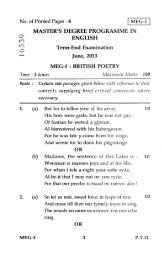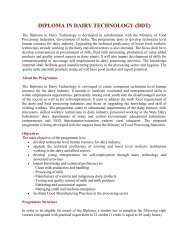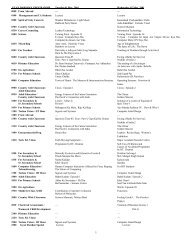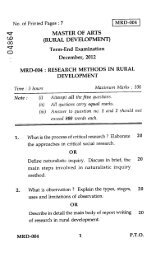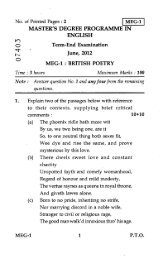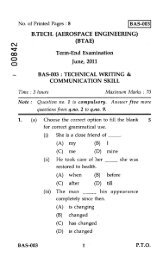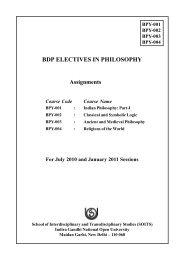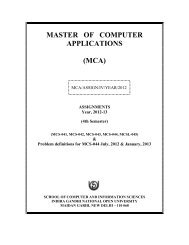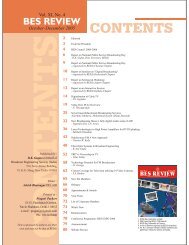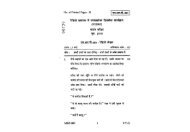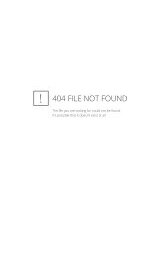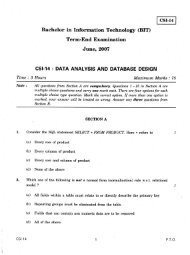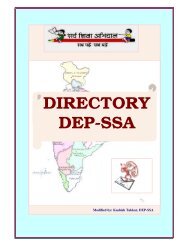You also want an ePaper? Increase the reach of your titles
YUMPU automatically turns print PDFs into web optimized ePapers that Google loves.
<strong>UNIT</strong> 7 <strong>BEARING</strong><br />
Structure<br />
7.1 Introduction<br />
7.2 Types of Bearing<br />
7.3 Journal Bearings<br />
7.4 Thrust Bearings<br />
7.5 Rolling Contact Bearings<br />
7.6 Roller Bearings<br />
7.7 Summary<br />
7.8 Answers to SAQs<br />
7.1 INTRODUCTION<br />
Bearings support the moving object which may have a rotary or translatory motion.<br />
Generally bearing is referred to as that machine part which supports a rotating shaft or<br />
axle. It is interesting to learn about bearings and also how they are supported in machine<br />
frame or in a much larger frame. We shall see the drawing of such bearings and supports<br />
in this unit.<br />
7.2 TYPES OF <strong>BEARING</strong><br />
Two basic types of bearing are used in practice :<br />
(a) Sliding contact bearings, and<br />
(b) Rolling contact bearings.<br />
7.3 JOURNAL <strong>BEARING</strong>S<br />
In sliding contact bearings the journal of the shaft rotates in the bearing. The bearing on<br />
the inside has the same cylindrical surface as the external surface of the shaft journal. The<br />
inside diameter of the bearing is only slightly greater than the outside diameter of the<br />
shaft. The difference is called clearance and is meant to be filled by lubricating oil which<br />
helps reduce friction and keep bearing cool. To increase the amount of lubricating oil<br />
grooves are often cut on the internal surface of the bearing. The oil gets stored in these<br />
grooves. In many other bearings oil is supplied though especially provided holes to feed<br />
the oil either continuously or intermittently. These bearings are called journal bearing.<br />
A single block bearing in which hole is bored to take shaft journal is called solid bearing.<br />
A bush bearing is the one in which a thin sleeve is inserted in the body and the shaft<br />
journal is supported in the sleeve. In case wear occurs the sleeve is either machined off or<br />
simply pushed out. A set screw (grub screw) is used to prevent any axial movement of<br />
the bush. The body of the bearing is made in cast iron which has two elongated holes in<br />
the base which allow adjustment of any misalignment.<br />
The bush is often made into two semi cylindrical pieces which fit into a perfect bush.<br />
There is a lower part with base in which half the bush is placed and a cap sits on the top.<br />
Such bearings called pedestal bearings or plummer blocks are used for supporting long<br />
shaft away from their ends. There are several split construction which accommodate oil<br />
entry and store holes. The bush normally carries flanges at the end to prevent any axial<br />
displacement. The split bush is normally called brass and ends are so made that rotation<br />
is prevented. To avoid any interference with wall of the pulleys or gears on the long line<br />
shafts the bearing blocks are often supported on especially made brackets of varied<br />
design. Figures 7.1, 7.2 and 7.3 show some journal bearings.<br />
Bearing<br />
109
110<br />
Machine Drawing<br />
7.4 THRUST <strong>BEARING</strong>S<br />
Figure 7.1 : A Solid Bearing<br />
Figure 7.2 : A Pedestal Bearing<br />
Figure 7.3 : The Cap of a Split Journal Bearing<br />
There are shafts which carry axial thrust in addition to radial loads or only axial thrust.<br />
Bearings are provided either somewhere along the length or at the end of the shaft. For<br />
horizontal shaft collars thrust bearings are used at any suitable section. For vertical shaft<br />
the support provide at the bottom is called pivot or foot step bearing.<br />
SAQ 1<br />
Figure 7.4 shows a bush type journal bearing. Draw<br />
(a) Elevation with right half in section,<br />
(b) Side view with left half in section.<br />
Figure 7.4
SAQ 2<br />
SAQ 3<br />
SAQ 4<br />
Figure 7.5 shows a pedestal bearing. Draw elevation right half in section.<br />
Figure 7.5<br />
(a) Draw side view with left hand half in section of pedestal bearing in<br />
Figure 7.5.<br />
(b) Draw plan in full view of pedestal bearing shown in Figure 7.5.<br />
Figure 7.6 shows the cap of a journal bearing. Draw three views<br />
(a) Elevation<br />
(b) Plan<br />
(c) Side view (full section)<br />
Figure 7.6<br />
Bearing<br />
111
112<br />
Machine Drawing<br />
SAQ 5<br />
Figure 7.7 depicts a footstep bearing. Draw elevation right half in section and plan<br />
full in view.<br />
Figure 7.7<br />
7.5 ROLLING CONTACT <strong>BEARING</strong><br />
In rolling contact bearings there are three essential elements. There are two concentric<br />
rings (called races) between which balls or rollers are placed such that the ball or rollers<br />
can roll between outer surface of inner race and inner surface of the outer race. The shaft<br />
journal is fitted in the inner race and outer race is supported in body of the machine. To<br />
ensure that the rolling elements do not cluster but they roll at a fixed distance from each<br />
other a fourth element called cage or separator is also placed between the inner and outer<br />
races. Since the coefficient of rolling friction is much smaller than that in sliding these<br />
bearings are also called antifriction bearings. Strictly speaking they are not without<br />
friction. Figure 7.8 shows the cut view of a ball bearing in which rollers are spherical<br />
balls. The rollers can be cylinders, tapered cylindrical with or without curved surfaces.<br />
These bearings are often meant for carrying radial reactions but ball bearings can carry<br />
considerable thrust. Yet some thrust ball bearings are also in use. Figure 7.9 shows some<br />
types of bearing.<br />
Figure 7.8 : A Ball Bearing
Single Row Radial<br />
Ball Bearing<br />
Double Row Radial<br />
Ball Bearing<br />
Single Row Radial<br />
Thrust Bearing<br />
Figure 7.9 : Some Types of Ball Bearing<br />
Double Row self<br />
Aligning Ball Bearing<br />
The rolling contact bearings are standardized in dimensions and sold in the market under<br />
the trade names such as SKF, Timken, NBC etc. Antifriction Bearing Manufacturing<br />
Association (AFBMA) has evolved code of numbers which give idea about dimensions.<br />
The defining dimensions are bore (d) outer diameter (D), width (B) and corner radius (r)<br />
as shown in Figure 7.10. Manufacturers tables describe these dimensions. The last two<br />
digits of the code number represent a number one fifth of bore or inner diameter. The<br />
D + d<br />
diameter of the centres of the roller is called mean diameter dm<br />
= .<br />
2<br />
SAQ 6<br />
Figure 7.10<br />
SKF 6208 bearing has 9 balls each of 12 mm diameter. The single row bearing has<br />
following dimensions.<br />
Outer diameter, D = 80 mm<br />
Bore or inner diameter, d = 40 mm<br />
Width, B = 18 mm<br />
Corner radius, v = 2 mm<br />
Draw elevation half in section and side view full.<br />
Bearing appears as shown in Figure 7.8.<br />
Bearing<br />
113
114<br />
Machine Drawing<br />
SAQ 7<br />
Figure 7.11 shows four bearings fitted in position. Bearings are restrained from<br />
sliding out though they are fitted tight on their seat. Draw the circled part of the<br />
Figure 7.11.<br />
7.6 ROLLER <strong>BEARING</strong>S<br />
Figure 7.11<br />
The rolling elements in these bearings are either cylindrical rollers or tapered rollers.<br />
Cylindrical bearings are used for only radial load. Some bearings with thrust lips<br />
provided either in outer or inner race can take minor thrust. Tapered roller bearings can<br />
carry considerable thrust along with radial load. See Figures 7.12, 7.13 and 7.14.<br />
Roller Bearing with<br />
Lips in Outer Race<br />
Roller Bearing with<br />
Lips in Two Race<br />
Figure 7.12<br />
Figure 7.13 : Roller Bearings Shown in Elevation<br />
Taper Roller Bearing
SAQ 8<br />
Figure 7.14 : Elevation of a Taper Roller Bearing and Nomenclature<br />
In a taper roller bearing D = 35 mm, d = 15 mm, B1 = B2 = 11 mm, t1 = 1 mm,<br />
t2 = 1 mm , R = R1 = 1 mm . Draw elevation.<br />
7.7 SUMMARY<br />
Bearings of sliding and rolling contact type were introduced. Several of them have been<br />
drawn. Some drawings have been shown in assemble. The reader will familiarize with<br />
methods of drawing several bearings.<br />
7.8 ANSWERS TO SAQs<br />
SAQ 1<br />
See Figure 7.15.<br />
Elevation (Right Half in Section) End View (Left Hand in Section)<br />
Figure 7.15<br />
Bearing<br />
115
116<br />
Machine Drawing<br />
SAQ 2<br />
SAQ 3<br />
See Figure 7.17.<br />
Figure 7.16 : Elevation (Right Half in Section)<br />
Figure 7.17 : Side View of Pedestal Bearing of Figure 7.5<br />
Figure 7.18 : Plan (Full View)
SAQ 4<br />
SAQ 5<br />
Figure 7.19 shows three views.<br />
Figure 7.19<br />
Figure 7.20<br />
Bearing<br />
117
118<br />
Machine Drawing<br />
SAQ 6<br />
SAQ 7<br />
SAQ 8<br />
Elevation (Upper Half in Section) Side View (Front Half or Cage Removed)<br />
Figure 7.21<br />
Figure 7.22<br />
Figure 7.23



